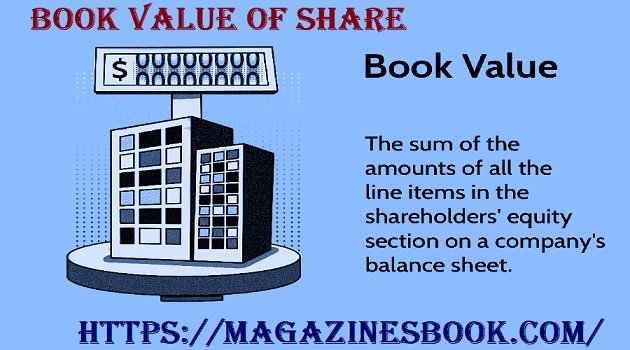Introduction to Book Value of Share
When evaluating a company’s financial health and determining if its shares are undervalued or overvalued, the book value of a share becomes a critical metric. This guide will delve into the definition, importance, and practical applications of book value, equipping you with essential insights for better investment decisions.
What is Book Value of Share?
The book value of a share refers to the value of a company’s equity as recorded in its financial statements, divided by the number of outstanding shares. In simpler terms, it’s the net worth of the company per share from an accounting perspective.
- Formula:
- Key Components:
- Shareholders’ Equity: The total assets of the company minus total liabilities.
- Preferred Equity: The equity attributable to preferred shareholders (if applicable).
- Outstanding Shares: The shares currently held by all shareholders.
Why is Book Value Important?
The book value of a share serves multiple purposes for investors and analysts:
- Valuation Metric:
- Indicates whether a stock is undervalued or overvalued compared to its market price.
- Stability Indicator:
- Highlights the company’s financial stability based on tangible assets.
- Reference for Liquidation:
- Shows the residual value of assets if the company liquidates.
- Aid in Comparison:
- Enables comparison across companies in the same industry.
Calculating Book Value: A Step-by-Step Guide
Let’s understand the calculation through a practical example:
Example:
Company XYZ reports the following in its balance sheet:
- Total Assets: $500,000
- Total Liabilities: $200,000
- Preferred Equity: $50,000
- Number of Outstanding Shares: 25,000
Calculation:
- Compute Shareholders’ Equity:
- Subtract Preferred Equity:
- Divide by Outstanding Shares:
Thus, the book value per share is $10.
Advantages of Using Book Value
- Transparency: Provides a straightforward measure based on audited financial statements.
- Conservative Estimate: Reflects tangible net worth, excluding speculative market factors.
- Benchmark for Long-Term Investments: Helps identify undervalued stocks for value investors.
Limitations of Book Value
While useful, book value has its constraints:
- Does Not Account for Market Dynamics:
- Excludes intangible assets like brand value and intellectual property.
- Subject to Accounting Practices:
- Depreciation and amortization can affect book value significantly.
- Limited for Tech Companies:
- High-growth industries often have lower tangible assets.
Book Value vs. Market Value
The market value of a share is its price on the stock market, influenced by supply, demand, and investor perception. Comparing these values helps investors determine if a stock is overvalued or undervalued.
| Aspect | Book Value | Market Value |
|---|---|---|
| Definition | Value based on financial records | Value determined by market price |
| Stability | Relatively stable | Highly volatile |
| Influenced By | Tangible assets and liabilities | Market trends and sentiment |
| Use Case | Assessing liquidation value | Measuring potential returns |
Real-Life Applications
- Identifying Undervalued Stocks: Stocks with market prices below their book values may indicate undervaluation, presenting buying opportunities.
- Evaluating Financial Health: Consistently high book values signal strong financial stability.
- Risk Assessment: Lower book values could indicate higher risks, especially for asset-intensive industries.
Trends in Book Value Analysis
- Impact of Technology: With the rise of tech companies, intangible assets are becoming more significant, reducing reliance on book value alone.
- Role in Value Investing: Investors like Warren Buffett use book value as one of many metrics to identify promising stocks.
Common Misconceptions
- Higher Book Value Always Means Better Stock: Not necessarily, as market dynamics and future growth potential play crucial roles.
- Book Value Reflects Intrinsic Value: Book value is just one component; intrinsic value involves more complex factors like cash flow and market conditions.
Practical Tips for Investors
- Combine book value with other metrics like Price-to-Book (P/B) Ratio, Earnings per Share (EPS), and Debt-to-Equity Ratio for a holistic analysis.
- Regularly review financial statements to track changes in book value over time.
- Use book value as a starting point, not the sole criterion, for investment decisions.
Table: Key Metrics Comparison
| Metric | Definition | Formula | Purpose |
| Book Value per Share | Net worth per share | BVPS Formula (above) | Stock valuation |
| Price-to-Book Ratio (P/B) | Market price compared to book value | Market Price / Book Value | Identifying undervalued stocks |
| Debt-to-Equity Ratio | Measure of financial leverage | Total Debt / Total Equity | Risk assessment |
| Earnings per Share (EPS) | Profit attributable to each share | (Net Income – Preferred Dividends)/ Outstanding Shares | Measuring profitability |
Disclaimer
This article is for informational purposes only and does not constitute financial advice. Readers are advised to consult a financial advisor or conduct their own research before making any investment decisions. The accuracy of the calculations and interpretations is not guaranteed, as financial data may vary over time.
